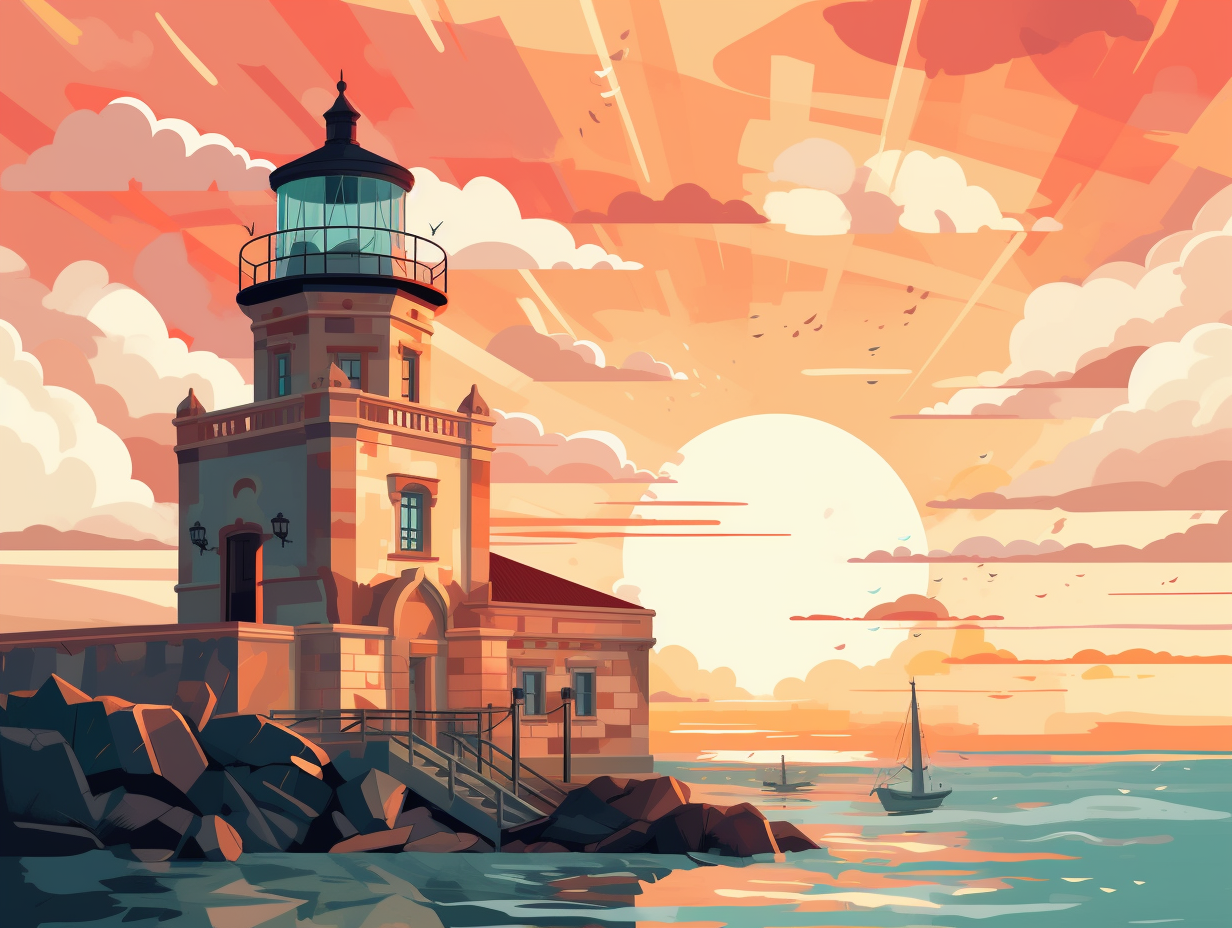13 Enlightening Fun Facts About the Lighthouse of Alexandria: Discover the Wonders of the Ancient World

1. Moth Party-Free Beginnings
The Lighthouse of Alexandria, contrary to its name, didn't actually start out as an ancient hotspot for moth parties: The lighthouse was initially constructed without an accompanying flame for guiding ships, serving purely as a navigational aid with its distinctive towering white structure and multiple floors.
Source => worldhistory.org
2. Architectural Jenga
The Lighthouse of Alexandria was ancient world's answer to a game of architectural Jenga: starting with a bulky square base and delicately stacking an octagonal midsection and a circular segment on top, creating a tower that would give modern skyscrapers a run for their money. Talk about keeping things light and breezy: standing at an impressive 100 meters (330 feet) tall, this lighthouse was among the tallest man-made structures of its time, with slight variations in Arab descriptions ranging from 103 to 118 meters (338 to 387 feet) on a 30 by 30 meter (98 by 98 feet) square base.
Source => en.wikipedia.org

Did you know the Great Sphinx of Giza's enigmatic grin is carved from a single massive limestone block? Discover the secrets of the world's largest monolithic statue, and why its nose is mysteriously missing!
=> Fun Facts about The-Pyramids-Of-Giza
3. Multi-Functional Mirror Master
"Mirror, mirror on the wall, who's the most useful lighthouse of them all?" The Lighthouse of Alexandria could proudly claim that title in ancient times: Its towering height not only made it an impressive navigational aid, but it also cleverly used a furnace to light a fire for nighttime illumination and a strategically placed mirror to reflect sunlight during the day, making it one of the earliest known practical applications of mirrors.
Source => en.wikipedia.org
4. The 12-Year Lighthouse Build
They say Rome wasn't built in a day, and neither was the Lighthouse of Alexandria: it took a whopping 12 years, a crazy amount of silver, and one BFF architect to transform this ancient wonder into a towering reality: Completed during the reign of Ptolemy II's successor son, the project devoured a massive 800 talents of silver and had the architect Sostratus of Cnidus, who was buddy-buddy with both King Ptolemy I and Ptolemy II, at the helm.
Source => memphistours.com

5. Maritime Illuminati Trendsetter
You could say that the Lighthouse of Alexandria put the "petal to the metal" in maritime Illuminati: This behemoth of a beacon didn't just leave sailors starry-eyed with its celestial guidance, but also went on to define lighthouse architecture with its impressive scale and grandeur, even though it didn't directly inspire its Mediterranean counterparts.
Source => wonders-of-the-world.net
6. Pre-Flashlight Glow Up
In a time before skyscrapers and flashlight apps, mankind needed a beacon of hope to light the way – and Pharos sure didn't disappoint with its glow up: The Lighthouse of Alexandria was designed with burnished bronze mirrors to intensify the fire's light, boasting a reflection range of up to 35 miles, making it one of the tallest and most innovative manmade structures of its time.
Source => egyptianmuseum.org
7. Versailles' Beachside Cousin
If Versailles Palace had a wild beachside cousin, it would definitely be the Lighthouse of Alexandria: This ancient tourist hotspot not only boasted an observation platform with a snack bar, but it towered between 380-440 feet making it the tallest building in the world for centuries, and featured a polished bronze mirror that projected its blazing beacon up to 30 miles out into the sea!
Source => bookbrowse.com
8. No AAA Batteries Required
Say goodbye to the ancient AAA batteries: the Lighthouse of Alexandria actually used a polished bronze mirror to reflect the flickering light of a massive fire atop its grand structure, debunking the popular belief in a constant beam that could be seen from over 30 miles away.
Source => bookbrowse.com
9. Saviour Gods' Nightlight
Behold, the ancient "Save Me" beacon for sea-lovers and fish whisperers alike: The Lighthouse of Alexandria was once dedicated to the "Saviour Gods," with its walls adorned by the crafty Sostratus of Cnidus and its tower sporting images of mythical hard-hitters such as Triton, Poseidon/Zeus – all to guide weary sailors into the Great Harbour of Alexandria, a bustling maritime pitstop once connected to the port of Eunostos by a sea bridge. The lighthouse may have crumbled thanks to earthquakes playing whack-a-mole with its structure, but the ruins were discovered by underwater archaeologists and remain a treasure trove of cultural significance in Egypt.
Source => en.wikipedia.org

10. Ptolemaic Status Symbol
Much like a celestial nightlight guiding the way for Ptolemaic sleepwalkers, the Lighthouse of Alexandria was also an ancient version of a "look-at-me" status symbol: A magnificent tower, bearing engravings dedicated to Zeus, it not only served as a beacon for seafarers, but showcased the wealth and power of the ruling dynasty while hosting important religious ceremonies. However, contrary to popular belief, the Pharos of Alexandria did not host international soirees, as our ancestors' e-vite papyrus records remain disappointingly empty.
Source => artincontext.org
11. Friendly Fire Guide, Not Inferno Ray
If you've ever witnessed a magnifying glass-sun-ant situation and thought the Lighthouse of Alexandria doubled as a scorching Inferno Ray for enemy ships, you'd be sizzlin' up the wrong story: The truth is, the renowned lighthouse simply relied on a curved metallic mirror to reflect sunlight by day and magnificent fires to illuminate the harbor at night – a trusty guiding light for over 1500 years, sans the drama of spontaneous combustion.
Source => jslandor.com
12. Leaning Tower's Blazing Older Sibling
Before the Leaning Tower of Pisa was just a twinkle in an architect's eye, the world had another not-so-straight light guide that literally set the night on fire for ancient mariners: The Lighthouse of Alexandria, built in 279 B.C., stood at a dizzying 135 meters tall and was the tallest man-made structure of its time. This ancient beacon used good old-fashioned burning coconut wood to light the way for ships, and though it was finally laid low by a series of earthquakes in the 14th century, its legacy lives on in the modern term "Pharos," which now refers to lighthouses and navigation aids.
Source => tokokai.org
13. Earthquake Wrecking Crew
The Lighthouse of Alexandria, once the beacon of high hopes, served as Earth's earliest skyscraper until a natural wrecking crew shook things up: This mighty "Pharos of Alexandria," standing at 400 feet tall, outlasted various sieges before falling victim to a series of earthquakes in the 14th century, proving that not even ancient wonders can stand tall in a game of shaky ground.
Source => en.wikipedia.org
Related Fun Facts




















